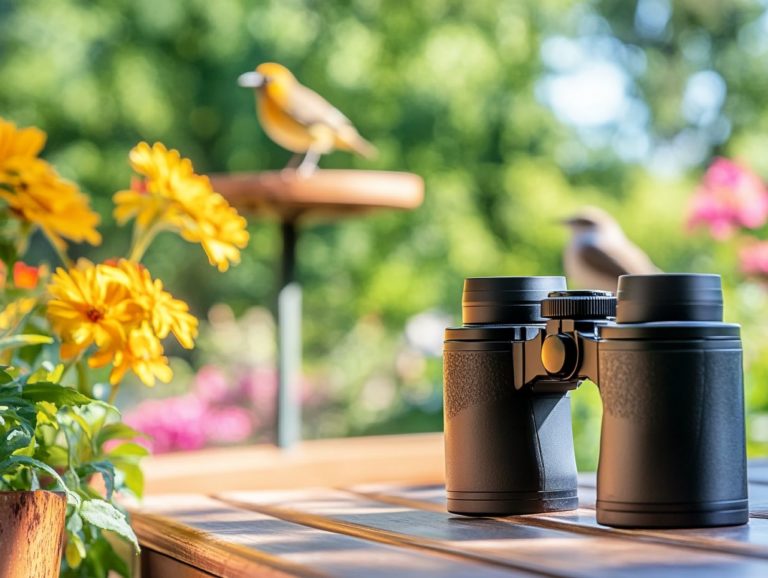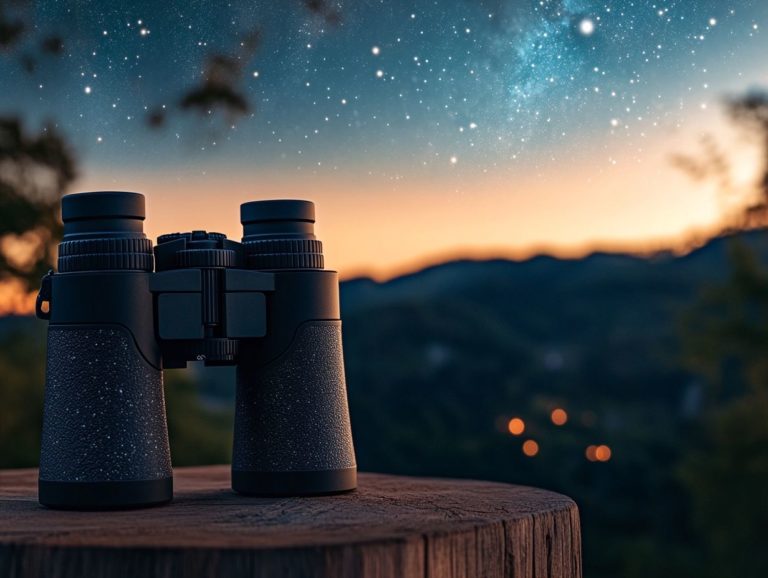Comparing Different Types of Binoculars for Birding
Birdwatching is a captivating hobby that invites you to connect with nature. Choosing the right binoculars can elevate this experience, allowing you to bring distant birds into sharp focus.
This article delves into essential features you should consider, such as magnification, lens size, and durability. It also provides a comparison of various types of binoculars compact, full-size, and zoom ensuring you find the perfect pair for your birding adventures.
Get ready to elevate your birdwatching experience like never before!
Contents
- Key Takeaways:
- Key Features to Consider
- Types of Binoculars for Birding
- Full-size Binoculars
- Zoom Binoculars
- Choosing the Right Binoculars for Your Needs
- Frequently Asked Questions
- What are the different types of binoculars used for birding?
- How do I know which type of binoculars is best for birding?
- What is the difference between roof prism and porro prism binoculars?
- Are there any specific features I should look for in binoculars for birding?
- How much should I spend on binoculars for birding?
- Can I use binoculars designed for other activities for birding?
Key Takeaways:

- Compact binoculars are lightweight and portable, great for birding on-the-go or for beginners.
- Full-size binoculars offer a larger field of view and better low-light performance, ideal for serious birders.
- Zoom binoculars provide adjustable magnification but may sacrifice image quality.
Why Use Binoculars for Birding?
Using binoculars for birding truly elevates your experience of observing wildlife, allowing you to appreciate the intricate details of birds, from their vibrant colors to their unique patterns and behaviors. With the right pair of binoculars, you ll enjoy enhanced clarity and brightness, essential for observing birds from a distance without losing any of their charm.
What distinguishes top brands in birding binoculars, such as Swarovski and Zeiss, is their unwavering commitment to great vision quality. This ensures you can experience natural colors and distinct features, even in challenging low-light conditions.
Lightweight designs and comfortable grips make these binoculars a joy to handle, allowing you to observe for hours without fatigue. These advantages enable you to spot elusive species with ease and capture fleeting moments, transforming each birding trip into a captivating adventure filled with remarkable discoveries.
Key Features to Consider
When selecting binoculars for birdwatching, it’s essential to consider key features that significantly impact their effectiveness and suitability for different viewing scenarios. By grasping how understanding binocular specifications for birders such as magnification, image quality, and eye relief enhance your experience, you can make well-informed choices.
Ergonomics should not be overlooked, as the weight and handling of the binoculars can influence your comfort during extended use. Evaluating the retail price and the available accessories can improve the overall value of your purchase.
Magnification and Lens Size
When selecting binoculars for birding, magnification and lens size are essential specifications that directly impact your image quality and ability to observe birds at varying distances. A popular choice among birders is the 8×42 configuration, striking a perfect balance between magnification and light-gathering capability, ensuring you enjoy clear images even in low-light conditions. By understanding these parameters, you can optimize your viewing experience and choose the model that best suits your specific needs.
For instance, if you opt for a higher magnification like 10×50, you may gain a more detailed view of distant birds, but be mindful that it could also result in increased shakiness and a narrower field of view, making it tricky to track fast-moving species. On the other hand, models with lower magnifications, such as 7×35, provide a wider field that can be particularly advantageous in dense woodlands, where birds can appear unexpectedly.
Each setup caters to unique viewing scenarios, whether you re scanning expansive landscapes or focusing intently on specific birds. This underscores the importance of considering both magnification and lens size to enhance your overall observation efficacy.
Field of View and Focus

The field of view and focus mechanism are key features of binoculars. They enhance your birdwatching experience by helping you quickly locate and track birds in motion.
A wider field of view offers a broader perspective of your surroundings, making it much easier to spot your targets.
Coupled with an efficient focus system, these features ensure that everything you see remains sharp and clear, elevating your overall image quality.
These elements go beyond mere comfort; they are crucial for capturing those fleeting moments when birds dart from branch to branch. Imagine spotting a vibrant warbler every detail counts!
A well-balanced combination of these capabilities allows you to maintain a steady gaze, enabling seamless tracking even during the swift movements of various species. This ultimately deepens your immersion in nature, transforming each outing into a richer experience.
Weight and Durability
When selecting binoculars for birding, weight and durability are essential factors to consider, especially if you enjoy extended outings in varied environments. Additionally, understanding the impact of prism type on birding binoculars can also enhance your viewing experience.
Opting for lightweight models enhances your portability and comfort, allowing you to carry your binoculars effortlessly throughout the day.
Equally important is their ability to withstand different weather conditions, ensuring they endure the rigors of outdoor use while still delivering exceptional performance.
Ergonomic designs significantly enhance usability, reducing strain on your hands and neck during prolonged periods of observation. For example, models with rubber armor not only offer a non-slip grip but also provide protection against impacts.
Choosing binoculars made from high-quality materials like magnesium ensures they withstand harsh conditions while maintaining excellent performance. Construction techniques like sealed optics keep debris and moisture out, allowing you to concentrate on your observations without worrying about the reliability of your equipment.
Types of Binoculars for Birding
You’ll find many types of binoculars designed specifically for birdwatching, each offering unique benefits, especially if you learn how to choose binoculars for long-distance birding.
Compact binoculars are lightweight and portable, making them perfect for those who prefer to wander while observing. In contrast, full-size binoculars deliver exceptional image quality and brightness, ensuring that every detail is visible.
If versatility is what you seek, zoom binoculars allow you to effortlessly adjust magnification, enabling you to adapt to various viewing situations with ease. Familiarizing yourself with these options can greatly enrich your birding experience.
Compact Binoculars
Compact binoculars are the perfect choice for birders like you who value portability and ease of transport without sacrificing too much image quality. For more information on selecting the right gear, check out this guide on how to select binoculars for bird watching tours. These lightweight binoculars slide easily into your backpack or pocket, making them incredibly convenient for those spontaneous birdwatching adventures.
Despite their smaller size, many compact binoculars feature advanced optics, ensuring you can enjoy bright and clear images in a variety of conditions.
Among popular choices, models like the Nikon Monarch 7 and the Vortex Diamondback shine with impressive performance metrics. Their high magnification and wide field of view make it easy for you to identify birds quickly, especially at events like the Audubon Convention.
Thanks to their waterproof design, these binoculars offer durability in diverse environments, giving you peace of mind as you explore. Their compact design is particularly suited for frequent travelers, allowing you to effortlessly access fascinating species on the go without compromising the quality of your viewing experience.
Full-size Binoculars

Full-size binoculars offer you exceptional image quality and brightness. They are the go-to choice for anyone who spends considerable time observing wildlife.
These binoculars come with larger lenses that gather more light, delivering clearer images even in challenging lighting conditions. Their sturdy construction ensures they can endure outdoor adventures while consistently providing optimal performance.
This advantage is especially clear with popular models like the Nikon Monarch M7 and the Celestron TrailSeeker ED. Both are celebrated for their sharp optics and ergonomic designs.
Whether you’re in a tranquil forest or at a birdwatching event hosted by groups like Wild Birds Unlimited, these binoculars excel at revealing the details of your surroundings.
The Monarch M7 is perfect for those magical moments at dawn or dusk, thanks to its outstanding low-light capabilities. The TrailSeeker ED also offers impressive color fidelity, enriching your experience as you observe vibrant species in their natural habitats.
Together, these features allow you to fully immerse yourself in your birding pursuits. Every outing becomes immensely rewarding.
Zoom Binoculars
Zoom binoculars provide remarkable versatility for birders. You can adjust magnification effortlessly based on the distance and size of the subjects you re observing.
This adaptability shines in dynamically changing environments, where distances can fluctuate significantly. You can relish a variety of viewing experiences.
Finding the perfect mix of zoom and image quality is key to an amazing birdwatching experience. Unlike fixed magnification models that offer a stable view, these zoom units let you tailor your perspective seamlessly.
Whether you’re spotting distant raptors or nearby songbirds, renowned brands like Canon and Nikon present premium models that merge optical excellence with user-friendly designs.
Take the Nikon Monarch series; it s celebrated for its clarity and durability, making it a favorite among outdoor enthusiasts. The Vortex Optics model is also revered for its impressive range and vibrant images, essential for capturing those fleeting moments in nature you never want to miss.
Choosing the Right Binoculars for Your Needs
Selecting the ideal binoculars for your birding adventures involves several considerations. Reflect on your specific needs, think about your favorite birding spots, the species you wish to observe, and refer to this guide on how to choose binoculars for bird watching regarding your preferences for image clarity and weight.
By thoughtfully assessing these factors, you can choose a pair that perfectly aligns with your unique style. This ensures peak performance as you immerse yourself in the beauty of nature.
Don t miss out on the breathtaking sights waiting for you. Act now to explore and choose your ideal binoculars!
Factors to Consider
When purchasing binoculars, focus on performance, ergonomics, and retail price. These elements significantly shape your birdwatching experience. To enhance your hobby, consider the best binoculars for backyard bird watching as you assess how image quality differs across models based on your specific needs, such as eye relief (the distance from your eye to the lens) and weight, especially if you plan to use them for extended periods. Balancing these aspects with your budget ensures a well-informed, satisfying purchase.
Performance includes factors like magnification and lens quality, both essential for spotting distant birds clearly. Ergonomics encompasses grip feel, weight distribution, and adjustment dials, all influencing how comfortably you handle binoculars during long outings.
Retail price presents a range of options, often requiring you to navigate trade-offs between premium quality and budget-friendly choices. Some birdwatchers lean towards high-end optical features, while others find a decent model at a lower price still enhances their experience without breaking the bank.
Ultimately, understanding these nuances will guide you in selecting binoculars that align with both your performance requirements and financial boundaries.
Frequently Asked Questions

What are the different types of binoculars used for birding?
There are three main types of binoculars for birding: standard, compact, and spotting scopes. Standard binoculars typically have a magnification power of 8x to 10x and are the most commonly used. For those interested in specific features, learning how to pick binoculars for birding tours can be very helpful. Compact binoculars are smaller and more portable, while spotting scopes are larger and offer higher magnification for long-distance birding.
How do I know which type of binoculars is best for birding?
The best type of binoculars for birding depends on personal preference and the type of birding you will do. For mostly short-distance birding, standard or compact binoculars will suffice. However, before making a purchase, it’s helpful to know what to look for when buying birding binoculars. For long-distance birding, a spotting scope may be a better choice.
What is the difference between roof prism and porro prism binoculars?
Roof prism binoculars have a straight-through design, making them more compact and lightweight. Porro prism binoculars have an angled design and offer a wider field of view. Both types can be used for birding, but roof prism binoculars are more commonly chosen.
Are there any specific features I should look for in binoculars for birding?
Yes, important features for birding binoculars include a wide field of view, good close focus capabilities, and image stabilization. Look for binoculars with high-quality optics, along with waterproof and fog-proof coatings.
How much should I spend on binoculars for birding?
You can find binoculars for birding at prices from under $100 to over $1000, so there’s something for every budget! It’s recommended to invest in a high-quality pair that lasts longer and provides better optics. However, good options are available at lower prices, so it ultimately depends on your personal preference and budget.
Can I use binoculars designed for other activities for birding?
While binoculars designed for activities like hunting or astronomy may have similar features, they’re not ideal for birding. For optimal bird watching, consider the tips for choosing binoculars for bird photography, as birding binoculars are specifically designed with features best suited for that purpose, such as a wider field of view and better close focus capabilities.






